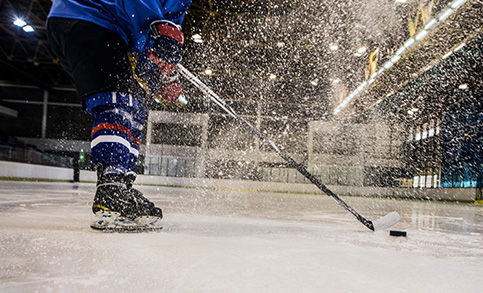Condensation, fog and uncomfortable atmosphere in indoor ice skating, ice hockey and curling rinks are results of humidity/ moisture. As the ice surface tends to get chilled it starts giving up moisture i.e. starts sweating. This leads to corrosion of metal and mold, fungus growth, etc. Also, the quality of ice suffers rendering the ice-skating surface uneven and unsafe due to the dripping of condensed water.
Effects of Uncontrolled Humidity
- Mold, Mildew and Fungal Growth leading to corrosion of infrastructure
- Uneven skating surface leading to fatal falls and injuries
- Safety hazards due to dripping of condensed water
Causes of Uncontrolled Humidity
Moisture migrates through the air from a higher concentration to a lower concentration due to a difference in vapour pressure. When air is cooled, it is unable to hold as much moisture. Thus, moisture will condense on any surface that has a lower temperature than the dew point temperature. This is a particular problem in Ice Skating rinks where the condensed moisture is deposited onto the surface of the ice in the form of water droplets and also in form of fog above the surface of the ice.
When moisture condenses and accumulates on the surface of the ice, it is known as “Frosting”. This “Frosting” in turn results in “Slow” ice and also imposes an additional load on the ice making system. These conditions cannot be solved by ventilation because introduction of outside air only aggravates the problem when the weather outside is mild and humid. Insulating the roof also aggravates drip during mild outside weather conditions. Low emissivity ceiling stays warmer and thus, reduce condensation and dripping.
To prevent condensation in the ceiling space and to eliminate the fog there are two approaches- refrigeration and desiccant dehumidification. In the past refrigeration air conditioning systems were used but due to high energy consumption leading to higher costs, desiccant dehumidification is preferred nowadays. Conventional refrigeration equipment can maintain space conditions in a skating rink of 7-15°C (45 to 60°F) at a relative humidity of 60% to 75%.
This can result in air so close to saturation that it actually forms a fog over the rink and condensation inside the building and on the surface of the ice. Any attempt to maintain lower humidity levels would necessitate maintaining evaporator temperatures lower than 32°F which results in frost formation on the evaporative coil. Thus, to conclude desiccant dehumidification is a more effective and energy efficient solution.
General Recommendation
The relative humidity in the Ice-Skating rinks should be maintained at 10% at about 11.3°C.
Bry-Air Solution
The primary advantage of a desiccant dehumidification system is its ability to dry air to a very low humidity level. A desiccant dehumidification system can very easily maintain 30-40 % relative humidity within the ice-skating rink thus, eliminating fog and condensation year-round, irrespective of outdoor weather conditions. According to the studies, conducted by ASHRAE and several manufacturers of desiccant systems, the average energy consumption of a desiccant dehumidifier is as much as 70% less than that of a comparable refrigeration system. So, desiccant dehumidification systems can eliminate fog and condensation while, at the same time, reducing operating costs. There is also the potential for a reduction in maintenance to the building and equipment inside as it is no longer subject to excessive humidity and the problems associated with it.
Reference List
- Ice Skating Rink, Shopping Fair, Malaysia













